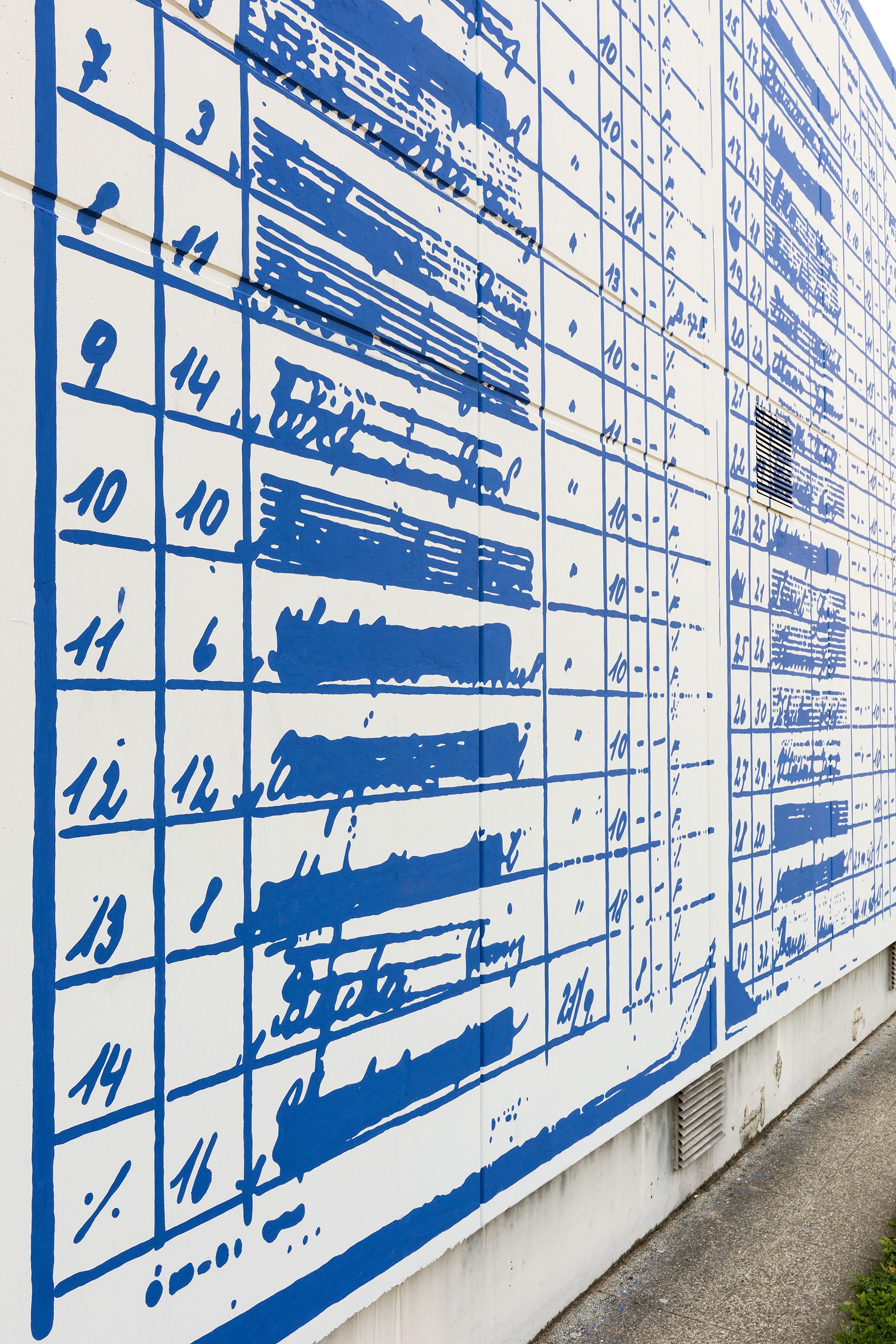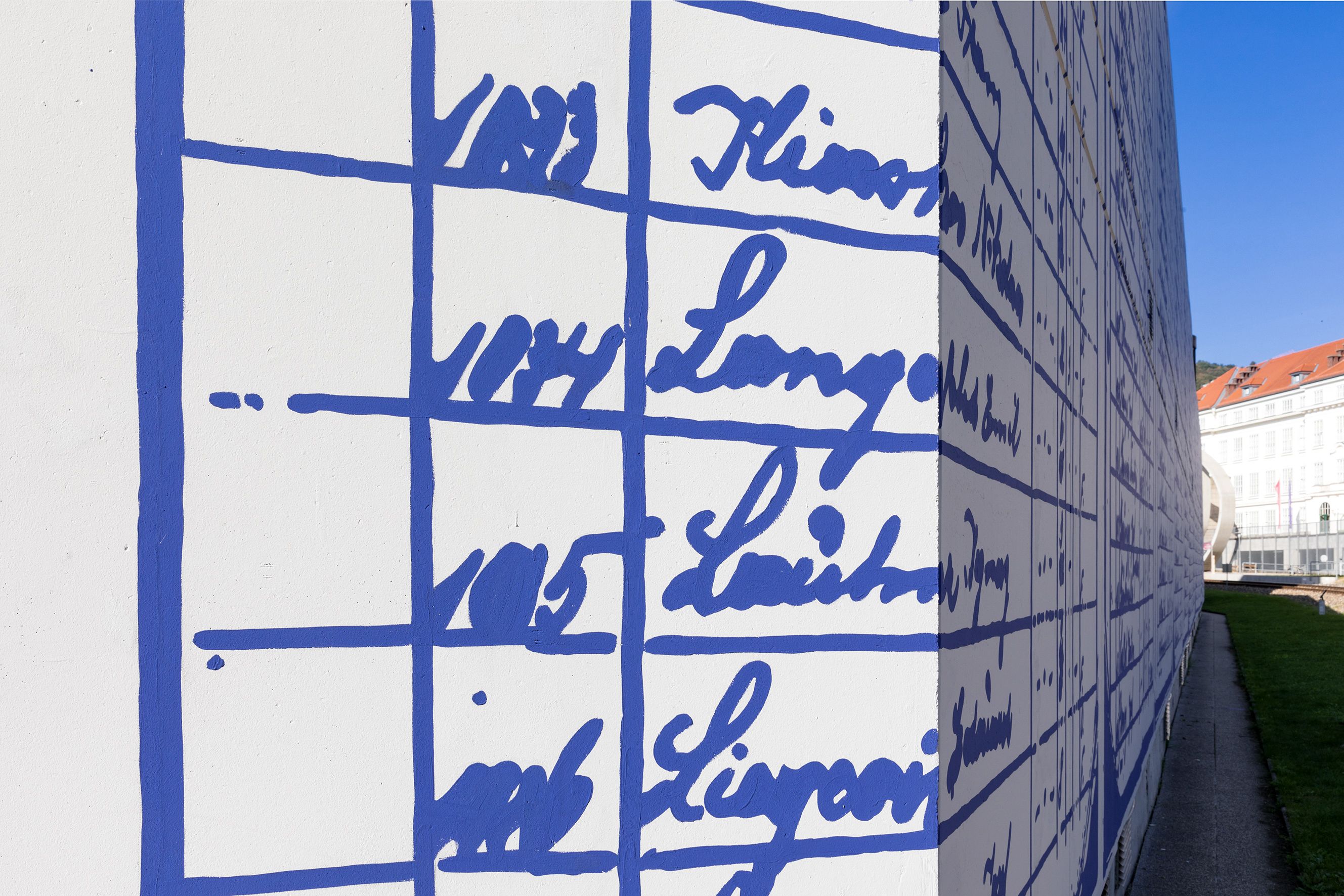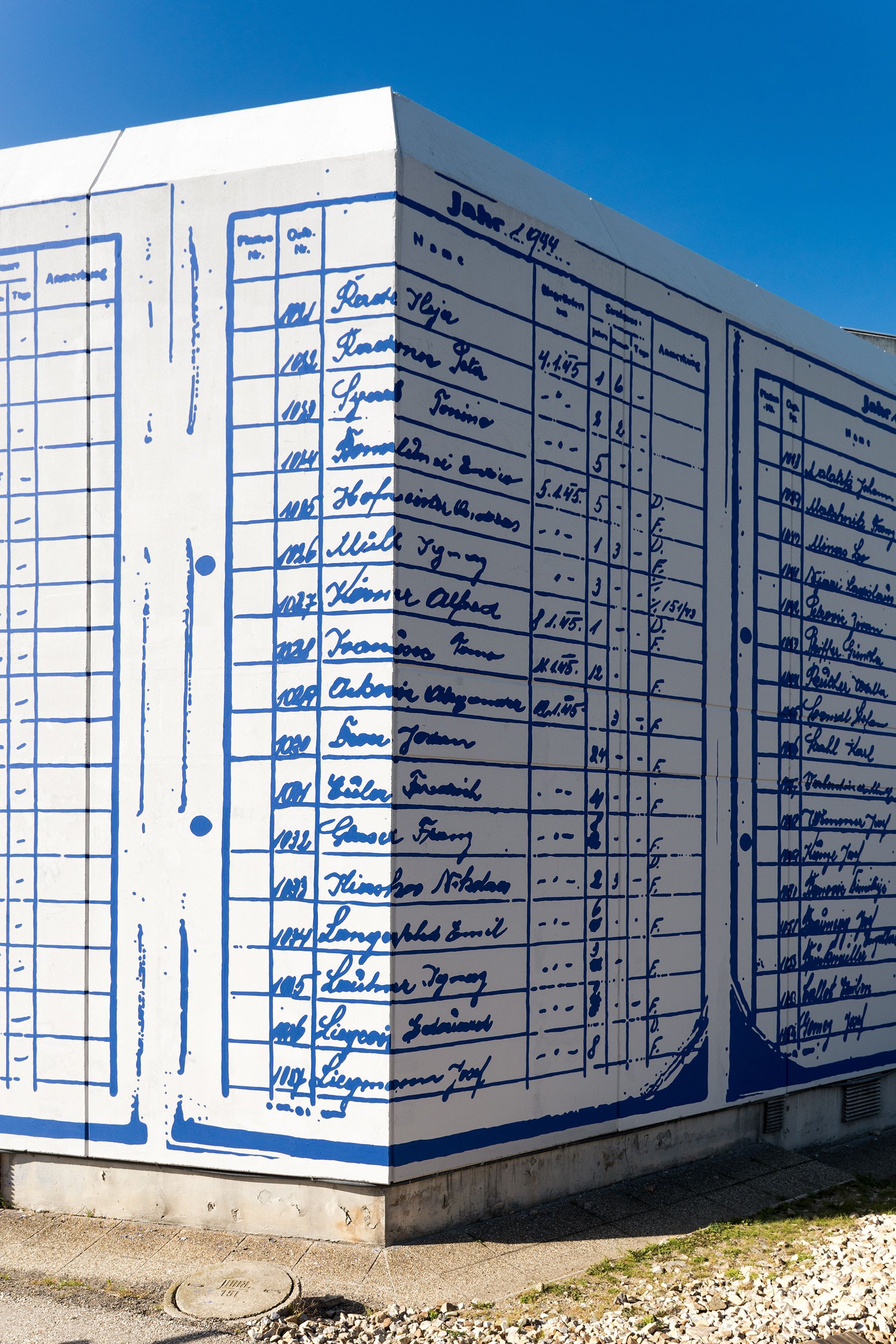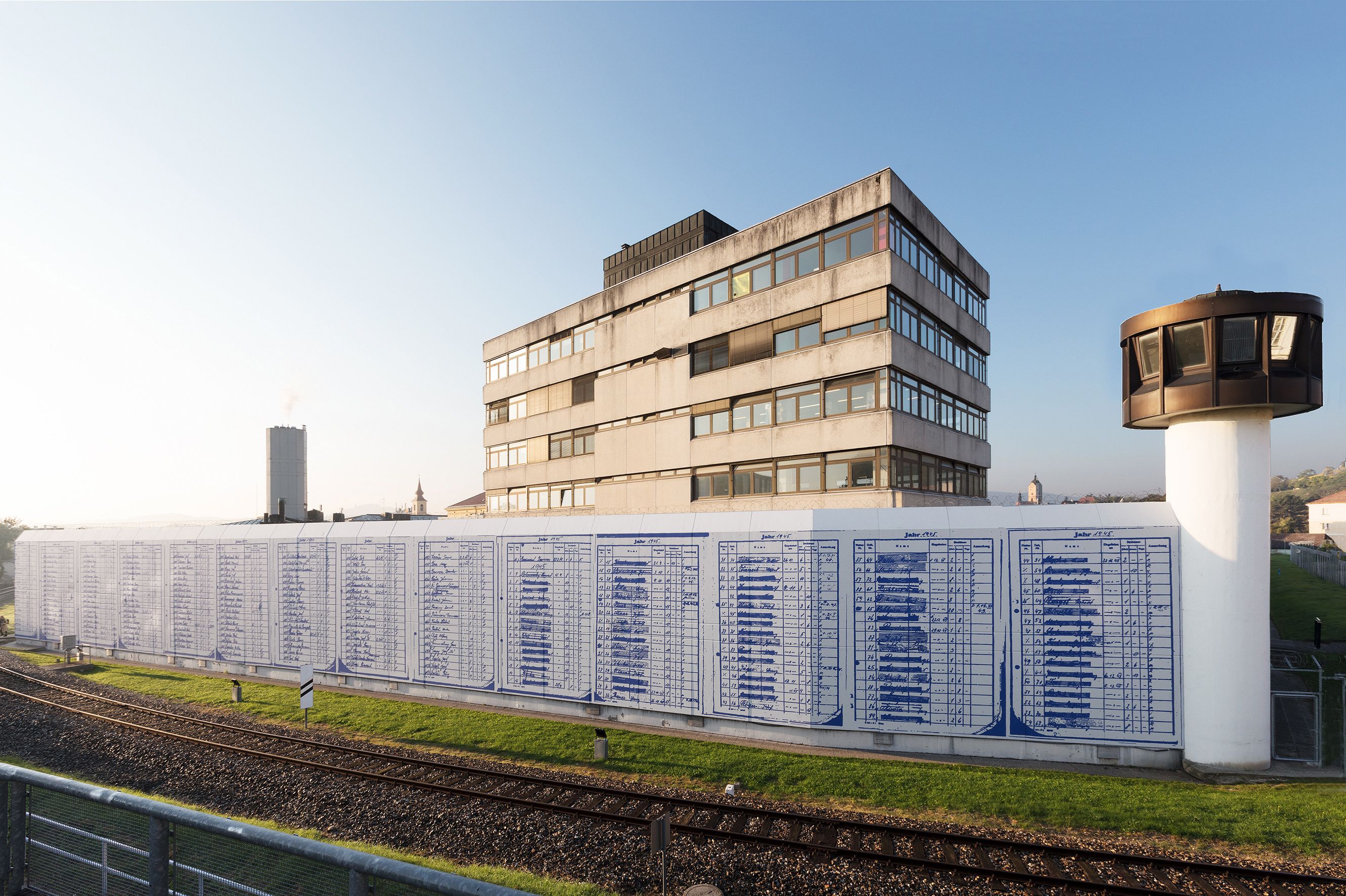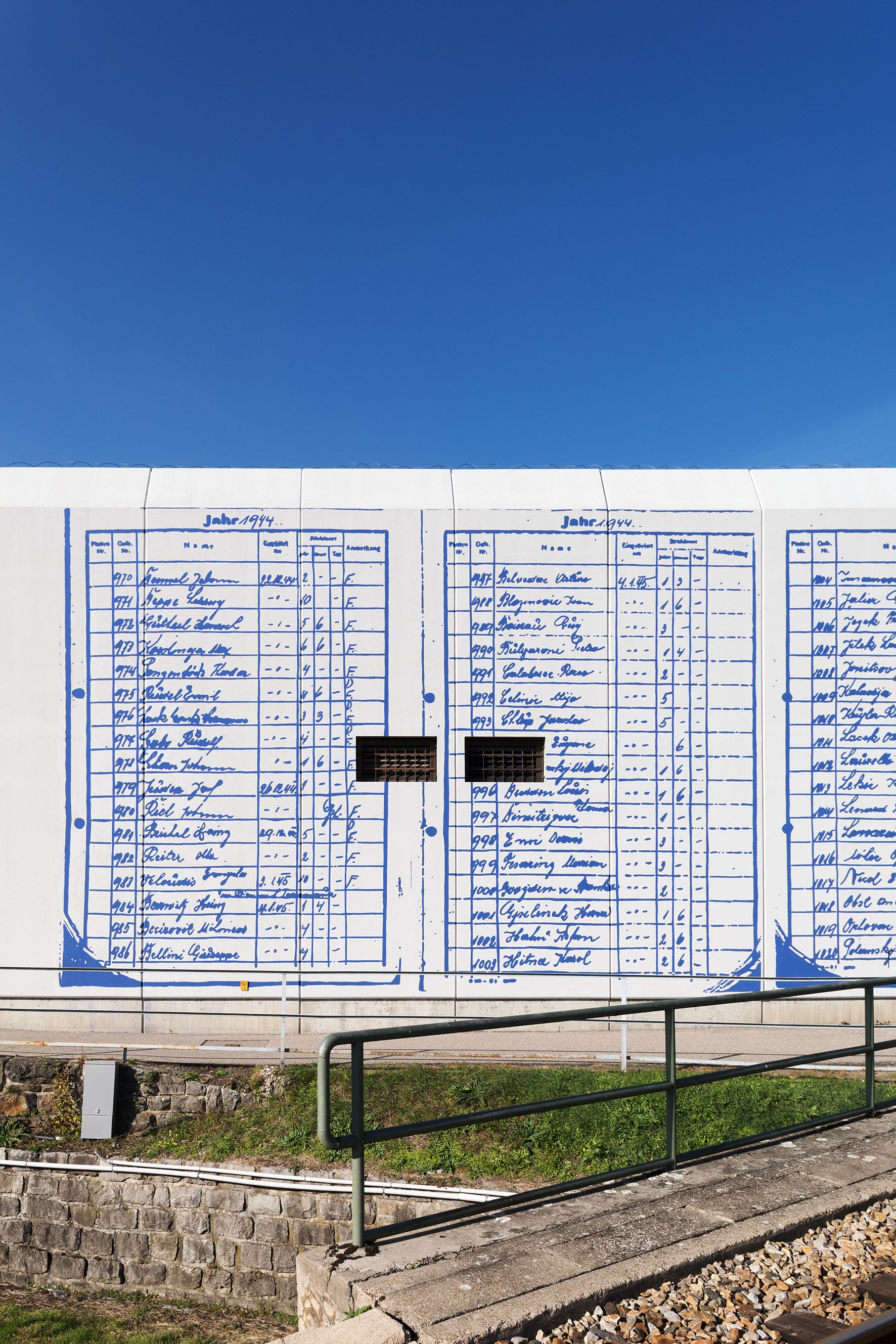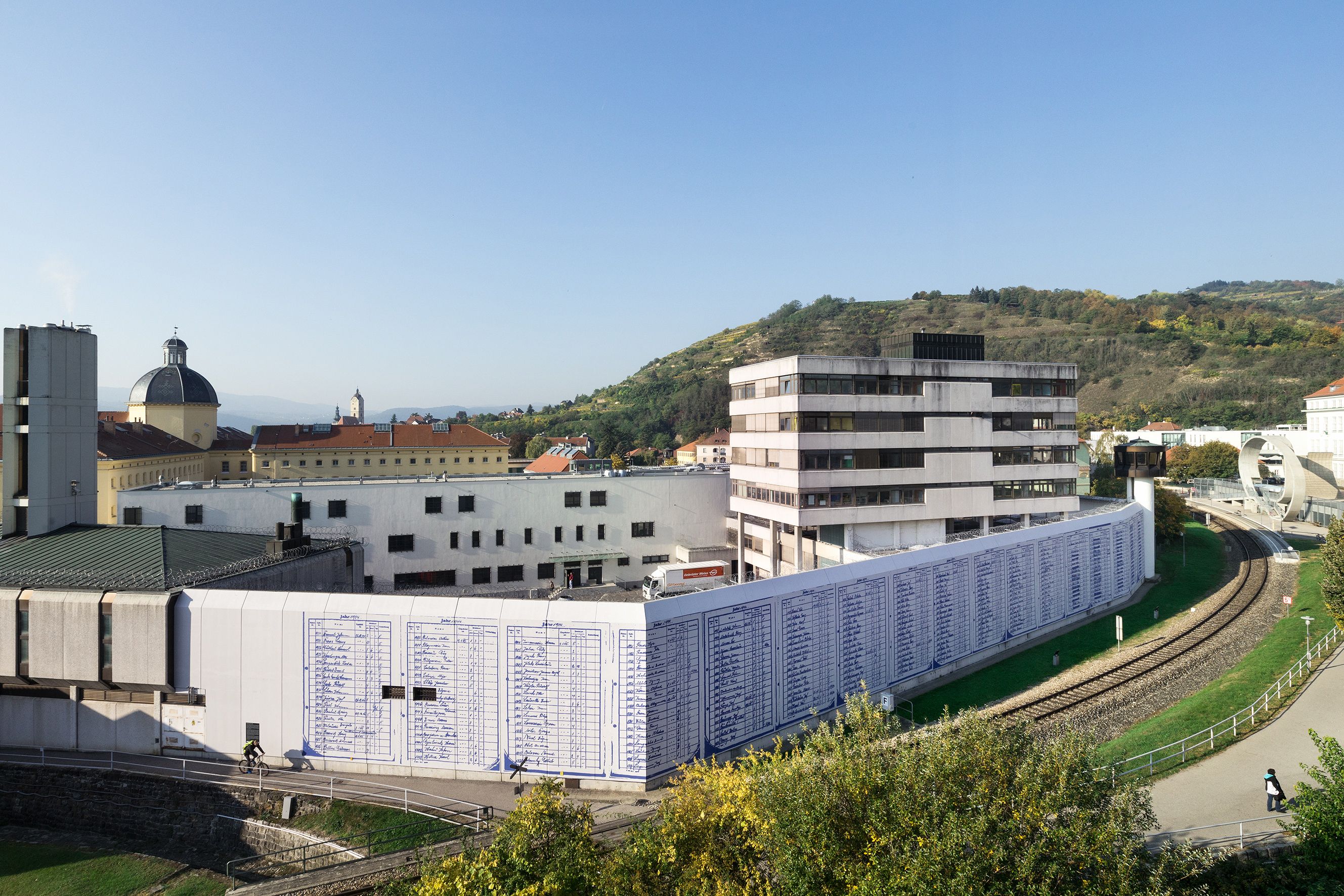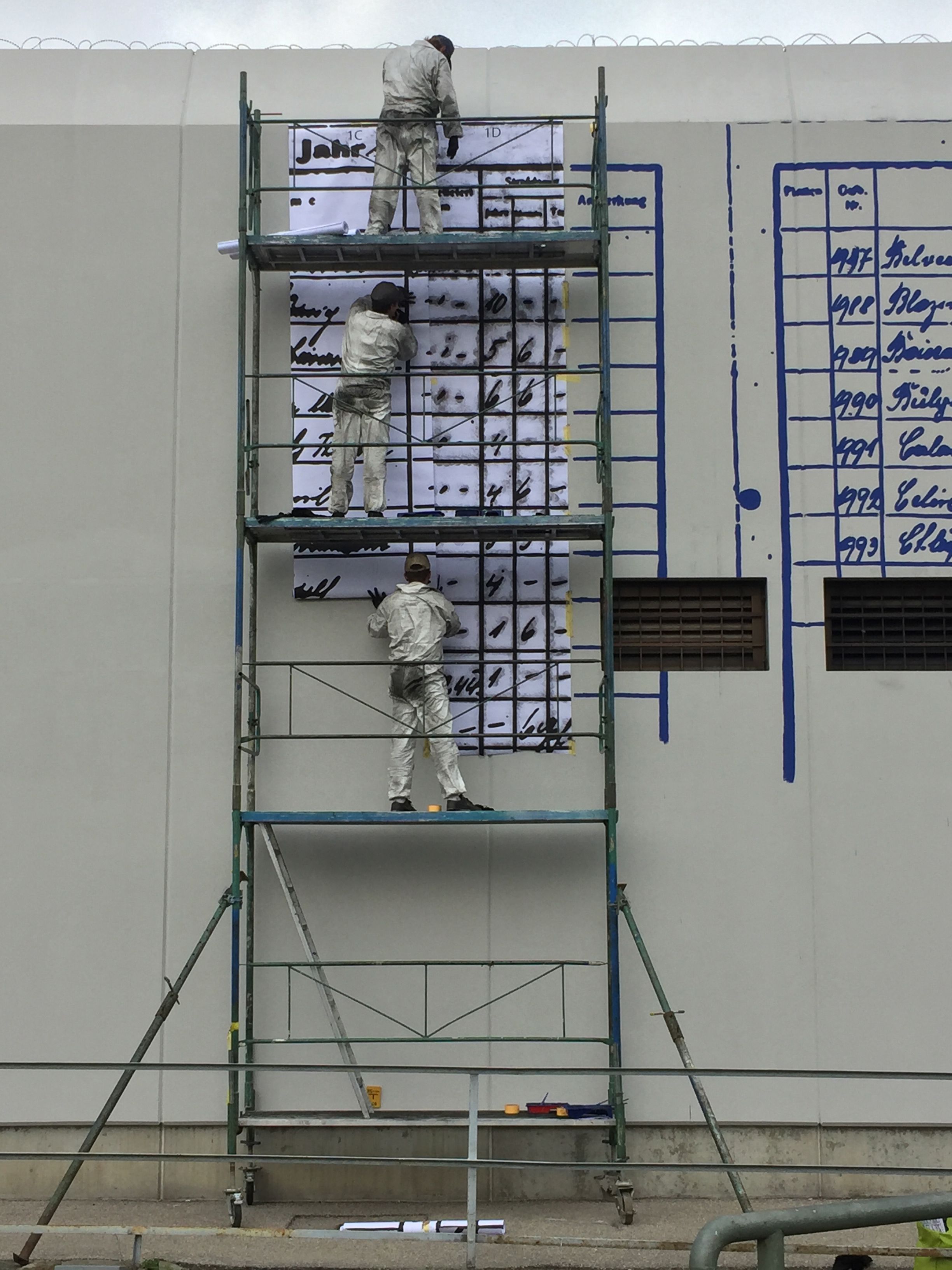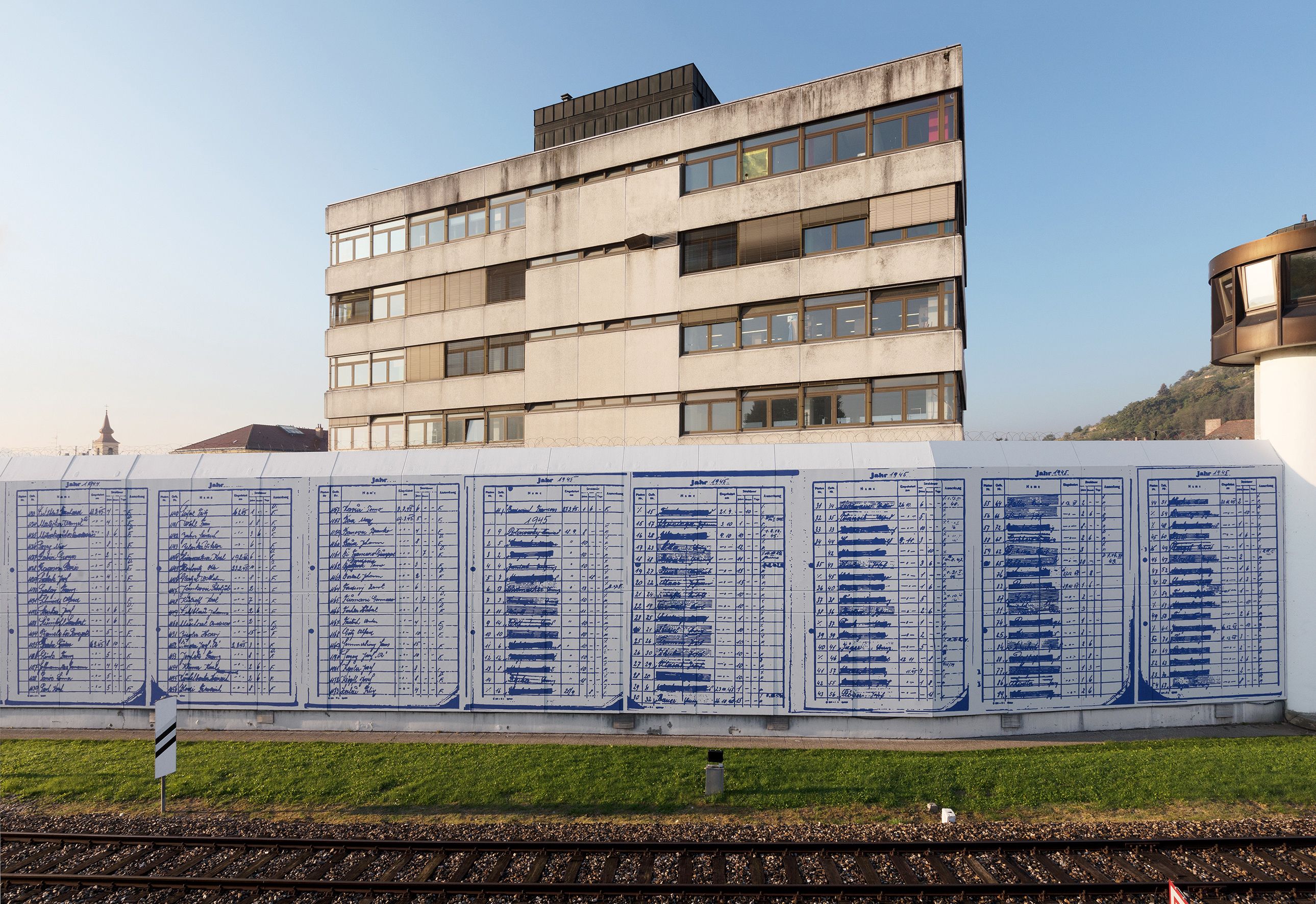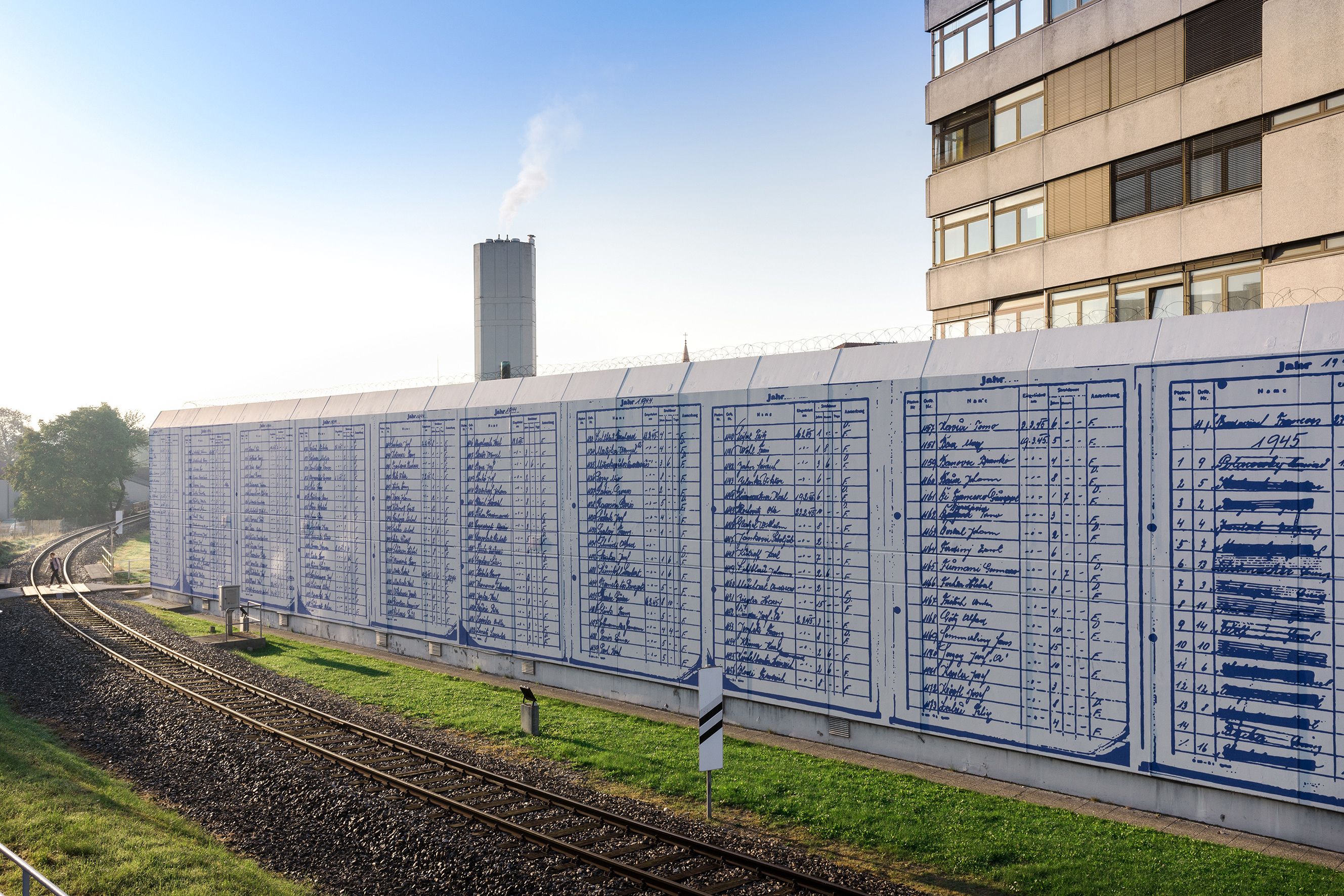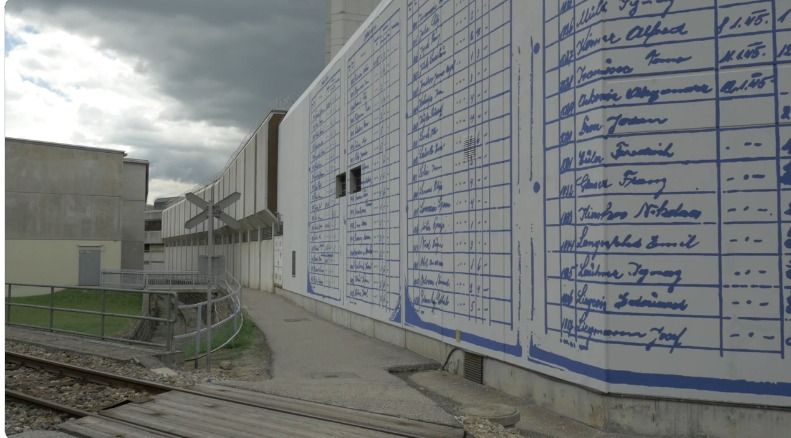Ramesch Daha
:
06.04.1945
Back
Information
On 6 April 1945, units of the Waffen-SS, Wehrmacht and SA, with the active assistance of local Nazi officials, murdered hundreds of mostly political prisoners who had just been released from the Stud House, as well as the director and threee prison guards. Ramesch Daha counters this unbelievable crime with the fact of a simple enumeration that fully senses the extent of the human catastrophe. She transferred fragments of the Prisoners´Register form 1944 and 1945 to the wall of the prison in a more than 100-meter-long mural painting. the individual pages of the register listing detainees at the detention center appear as well as oversized blueprints.
06.04.1945 is the title of the over 100 metre long and 7.5 metres high mural by Ramesch Daha on the wall of the Justizanstalt Krems-Stein, the second largest men's prison in Austria. The title is as concise as its historical background is complex — and the work's presence is equally formidable. The combination of numbers in the title is an allusion to 6 April 1945, and with this date to a massacre that took place within and around the prison just before the end of the Second World War. On that day hundreds of convicts, most of whom were political prisoners, and some inmates just released, as well as the prison director and three prison guards, were murdered by members of the SS, the regular army and the SA in collusion with the local Hitler Youth [1] . To commemorate this mass murder and the subsequent merciless hunt for the survivors, carried out in collaboration with local Nazi officials, Ramesch Daha has painted enlarged excerpts of the prison records from 1944 and 1945 onto the prison wall. The artwork is the first clearly visible, permanent sign of a public historical reappraisal in Krems [2] that addresses the extreme cruelty and fanaticism of the violence directed against civilians towards the end of World War Two.
A total of 17 copies of pages from the official records where the prisoners are listed by hand have been conscientiously transferred to the wall, complete with all of the traces left on the originals by the protracted official procedure. Individual crossings-out apply to prisoners after 1945, whose names are usually struck off the list when they have served out their sentences. The artist combined analogue techniques used by the Old Masters with digital copying technology. Initially hand-tracing from the archived copy of the prison records, she then enlarged these tracings in a digital photocopier and printed them onto long strips of paper. The outlines on these were perforated and then stencilled onto the wall through the holes. The resulting markings on the wall were then filled-in with blue paint, by hand. The pages from the prison records look like vast carbon copies, however the writing in the mural is so softly outlined that, although recognisably names that can sometimes even be guessed at, the lines are never actually legible. Ramesch Daha has laid a kind of soft filter over the individual fates concerned. On the one hand this filter protects the private spheres of the victims. On the other hand, though, while the individual narratives are present in the handwritten lists they are at the same time united in one powerful 'unanimous' reminder, which, going beyond pure documentation, creates a place of remembrance on a meta-level of formal synthesis where the perpetrators and the victims also encounter one another collectively. Ramesch Daha works before the background of a new concept for painting that intervenes actively in the public commemorative landscape by connecting historical information with a formal approach. In terms of content, 06.04.1945 is in the tradition of a classical memorial, commemorating a tragic event and its victims. In formal terms, however, it breaks with tradition, and with the associated pathos and its formal hierarchies. Insofar as Daha only takes fragments from the records as the basis for her mural and does not explicitly depict the names it contains, she creates a space between figurative painting and abstract painting that permits both moral and emotional empathy in the reception as well as critical reflection.
06.04.1945 emerged as the winning project in an invited entry competition to find a design for the prison wall that borders the Donau Universität Krems Campus — there were no restrictions regarding the contents. By focusing on a historical event for the subject matter, and although without a public commission to create a memorial, Ramesch Daha makes her work a collective place of remembrance, adopting responsibility as an artist for placing historical information in the public domain. In doing so she combines elements of her artistic practise with the claim to a new practical approach to memorials that is not confined to specific media. In earlier works, such as Victims of 9/11 , a series of portrait paintings of victims of the New York attacks of 11 September 2001, the artist was already engaging with complex historical events that established disastrous rifts in social conventions concerning human behaviour, while also contrasting individual images of faces with the official images. The formal genesis of these works is comparable with the compilation of a screenplay, Daha initially allows a vast range of documents in the form of text, photographs and maps from intense research and sketches to flow together, and subsequently translates them into paintings or multimedia installations. Ramesch Daha has simplified this combination of elements for the Krems mural. Employing her central medium, conceptual painting, she focuses on a clear visual statement. The enlargement of the historical prison records becomes profoundly symbolic of the complex historical background. But beyond this, the artist lets the rows of names speak, uncommented, for themself in the form of an ostensibly sober document. She eschews interpretation and narrative pathos, and confronts a crime that defies belief with the factual plausibility of a simple listing, through which the full extent of the human catastrophe can be inferred. Simultaneously, though, in rendering the names anonymous she inscribes them with the conceptual dialectic of remembering and forgetting that still lies today, in Krems and in other places, like a veil over the crimes committed by the Nazis.
[Cornelia Offergeld]
---------------
[1] See the essay by Robert Streibel in this booklet, as well as the exhaustive 1995 essay on the subsequent prosecution by Gerhard Jagschitz (ed.): Stein, 6. April 1945. Das Urteil des Volksgerichts Wien (August 1946) gegen die Verantwortlichen des Massakers im Zuchthaus Stein. Bundesministerium für Justiz, Dokumentationsarchiv des österreichischen Widerstands, Vienna 1995.
[2] A commemorative stone at Friedhof Stein cemetery is a memorial to all the victims of the massacre, another to the Polish resistance fighters executed in the prison, and a memorial on Steiner Landstrasse commemorates the Greek victims. In 1995, in a private initiative, 386 white wooden crosses were placed along the streets around the prison in an act of commemoration.
